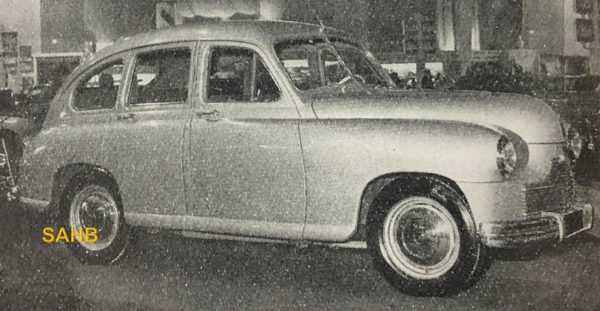
This Snapshot of the new Standard Vanguard was at its first motor show – but it was not in Britain. This picture was taken at the Brussels Salon d’Automobiles held from 14 to 25 February 1948. There was a strong Belgian connection to the launch of the Standard Vanguard: Impéria of Nessonvaux were assemblers of Standard and Triumph cars under licence. This was an important launch for Standard and they clearly made the most of it. To quote from the Motor Commerce report:
“The Vanguard made its first public appearance at Brussels, and was certainly a sight that gladdened the heart of British visitors. Mounted on a pedestal at the corner of the Standard-Triumph-Impéria stand, it stood out in its “champagne” finish, and attracted admiring crowds. There was much publicity in Brussels for the Standard and Triumph makes during the period of the show, and even the tramcars in the city carried, on their overhead poles, little pennants advertising them.”
The Standard Vanguard was announced in July 1947. It was completely new, with no resemblance to previous models. It was Standard’s first post-Second World War car and intended for export around the world. It was also the first model to carry the new Standard badge, a heavily stylised representation of the wings of a griffin.
In the wake of the Second World War, many potential customers in the UK and in English-speaking export markets had recently experienced several years of military or naval service, and therefore the car deliberately carried a name that would resonate strongly with potential buyers. Vanguard came from HMS Vanguard, the last of the British Navy’s battleships, launched in 1944 amid much media attention; permission to use the name involved Standard in extensive negotiations with senior Royal Navy personnel.
The styling of the car was intentionally modelled on the one from the 1942 Plymouth, although in 1952 some Soviet newspapers claimed that the vehicle’s styling was also partly inspired by the GAZ-M20 Pobeda.
The car began to roll off the assembly lines in mid-1948, but all production was destined for export. An estate car and a utility pick-up version were announced in September, and then a 12-cwt delivery van. For Belgium only, some convertibles were made by Impéria. Spats were fitted over the Vanguard’s rear wheels from September 1949.
Beneath the modern styling the chassis was conventional, with independent suspension at the front with coil springs, and a live axle and leaf springs at the rear. The brakes were cable-operated, and column gear change made the most of the interior space. The four-cylinder OHV 2,088cc engine was used until the appearance of the Six model in 1960. It was essentially the same powerplant as used on the Ferguson tractor.
At first, transmission was through a three-speed gearbox with synchromesh on all forward ratios. Laycock-de-Normanville overdrive was announced at the end of 1949 and became available in June 1950.
A sad postscript occurred in July 2021. Belgium experienced terrible weather, and the old Impéria factory at Nessonvaux, still home to a small car museum, was one and a half metres under water; the building had partly collapsed, and all the doors were gone. The collection of books, leaflets, drawings etc. of the Belgian Impéria brand were all lost. The fate of the test track is not recorded, but in 2018 it still existed in part: one of only three rooftop banked test tracks in the world (the others being Lingotto in Turin and Chrysler in Buenos Aires).
Photo courtesy of The Richard Roberts Archive.







Leave a Comment